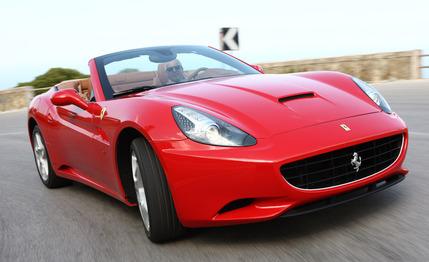
 First Drive Review
First Drive Review
Are you ready for a Ferrari to drive to the office, the mall, the beach, the slopes—anywhere, everywhere? That’s the concept behind this revival of a name from Ferrari’s storied past—a fast GT that supplies style, panache, plenty of performance, and thanks to its folding hardtop and “two-plus” interior layout, an unusually high level of all-around usefulness.
At the core of this concept is the hope that the California will attract buyers new to the brand, a notion that raises our eyebrows a degree or two since (a) the waiting list for a new Ferrari averages about 16 months, (b) U.S. Ferrari dealers have habitually given precedence to previous owners, (c) this car has no cup holders, and (d) its pricing will start at “about $200,000” in this country, according to the carmaker.
But never mind. These are issues for prospective owners. So let’s take a look at what Ferrari, Pininfarina (design), and Scaglietti (assembly) hath wrought.
Fabulous Ferrari Firsts
The California embodies a number of Ferrari firsts. For example, it’s the first Ferrari with a V-8 engine mounted ahead of the cockpit. Previous V-8s have been bolted in amidships, behind the seats. The V-8 is a development of the 4.3-liter eight that propels the superb (and soon to be replaced) F430 series, distinguished by new cylinder heads with a direct-injection fuel system, also a Ferrari first. The engine’s mass rides behind the front axle center line and sends its substantial thrust (453 horsepower, 358 pound-feet of torque) to the rear wheels via a rear-mounted dual-clutch automated-manual transmission, another first for Ferrari. This layout, on a 105.1-inch wheelbase, yields a 47/53-percent front-to-rear weight distribution, contributing to excellent balance, and handling that’s both exhilarating and benign.
The two-piece folding hard top, of course, is yet another element new to a car from Maranello, giving the California a fresh-air dimension in the tradition of its distinguished spider ancestors, plus the quiet comfort of a coupe. Beyond that, there’s a space behind the front seats that can serve as a parcel shelf or, if the owner checks the option box, plus-two seating for one or two limber passengers, preferably of diminutive dimensions. Ferrari presented this element of the new car as “2+,” refraining from referring to it as a classic two-plus-two, since the space, smaller than the rear seat in a Porsche 911, seemed a little too claustrophobic for human beings.
But that was before Ferrari president Luca di Montezemolo showed up, fresh from riding in the rear seat of a new California for “almost an hour,” and pronounced the space habitable. “I think it’s okay,” he said. “Probably not so good for three hours or so, but for short trips. It was a nice surprise.” How this will affect U.S. marketing communications remains to be seen—the California won’t be in North American showrooms until June—but after guiding Ferrari’s continuing success for 17 years, when Signor Montezemolo speaks, his staff takes heed.